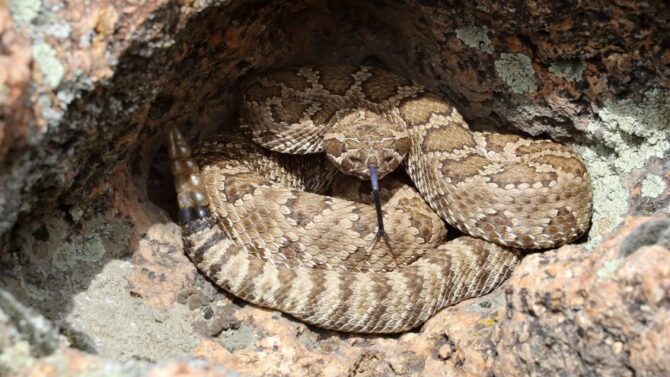Lake Tahoe is home to beautiful wildlife, but some of these animals can be deadly and should be avoided. Some of the most dangerous animals in Lake Tahoe include coyotes, mountain lions, rattlesnakes, etc.
Lake Tahoe, located deep in North America, is the second deepest lake in the U.S., between the shoreline of California and Nevada.
As a city in the middle of the forest, its roads courses through the home of some of the most beautiful animals.
People from around the world come to its shores for fun and to explore its beautiful landscape, vegetation, and fauna.
This article will give insights into 12 of Lake Tahoe’s most dangerous animals you should avoid, as well as safety tips for exploring wildlife in the area.
What are the Most Dangerous Animals in Lake Tahoe?
1. Coyote
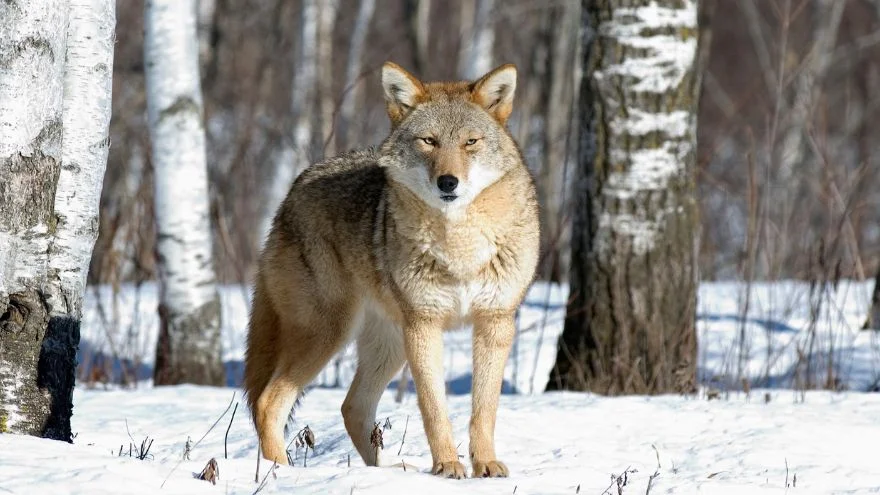
- Scientific name: Cans latrans
- Classification: Mammal
- Habitat: Forest, plains, deserts
- Diet: Omnivore
- Conservation status: Least concern
Coyotes native to Lake Tahoe play a crucial role in the ecosystem in the area. Their diet helps keep rodent populations in check.
Although sometimes mistaken for a wolf, coyotes are leaner than wolves, with big ears and bodies with fur varying in location.
These wild dog species can grow 2 to 3 ft. in length and weigh up to 46 lbs. as fully grown adults and can move with speed up to 40 miles per hour, leaping incredibly 13 feet into the air.
Unlike their cousins, the wolves, coyotes do not form packs; they usually hunt alone and, occasionally, in pairs to take down larger prey.
They have also been known to hunt effectively with other animals because, unlike other mammals, coyotes are highly evolved, intelligent, and can adapt to any situation.
Coyotes are not nocturnal like their cousins, but they hunt better at dawn or dusk. Coyote attacks on humans are rare, as they are shy and afraid of humans.
Notwithstanding these facts, reports show that coyotes will attack and possibly kill if threatened, provoked, or cornered, especially with their young ones.
2. Mountain Lion
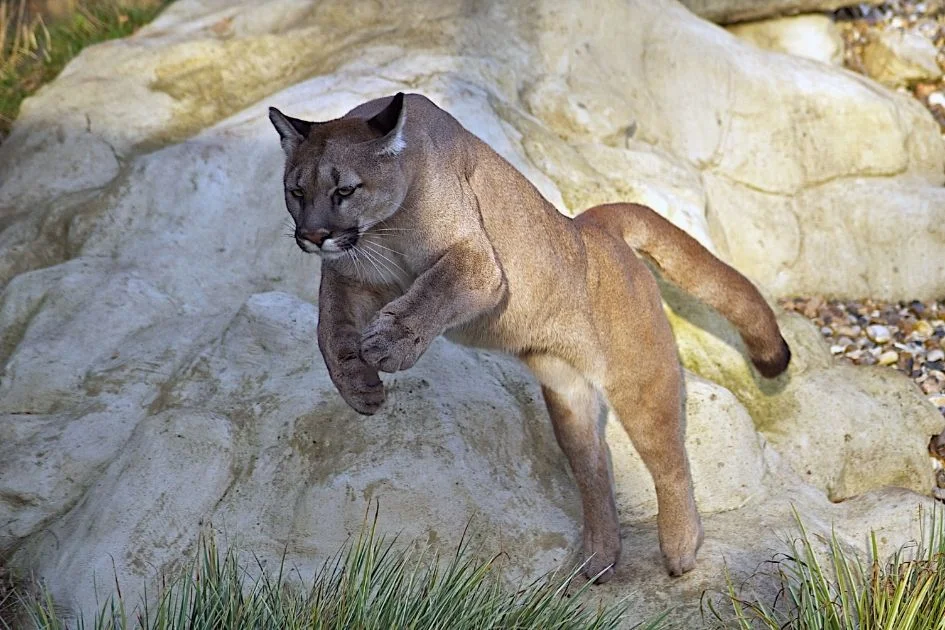
- Scientific name: Felis concolor
- Classification: Mammal
- Habitat: Forest and mountains
- Diet: Carnivore
- Conservation status: Least concern
Mountain lions, sometimes called puma, looks like an oversized house cat with a smaller face, smaller head, smaller and rounder ears, longer tails, and longer, smoother bodies.
They have powerful legs that help the leap on prey easily and run fast, up to 50 miles per hour.
An adult puma can grow to about 7 feet in length, 2 feet in height, and weigh up to about 150 lbs.
Mountain lions are solitary animals and prefer to live alone and like to mark their territories of about 30 square miles radius of the mountains.
These beasts love to maintain stealth and stalk their prey but will avoid encounters with humans by any means possible.
Peradventure they encounter human presence, these beasts are known to kill people, and they will stalk their prey as they are efficient killers.
Statistics show that there have been over 20 attacks on humans since 1986 and 3 have been fatal.
Most attacks on humans resulted from trespassing on their territory or because they felt threatened.
3. Bobcat
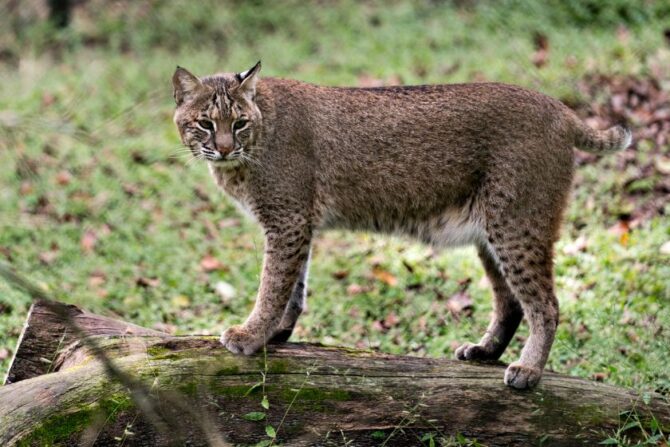
- Scientific name: Lynx rufus
- Classification: Mammal
- Habitat: Forest, coastal swamp, scrubland, mountains
- Diet: Carnivore
- Conservation status: Least concern
The bobcat is sometimes mistaken for the lynx because of how similar they look.
They are, in fact, smaller in size and feet, darker in color, have more markings on their body and short black tails, and can grow up to 15cm in length and weigh up to 18kg.
Bobcats sleep during the day in their den as they are solitary and nocturnal animals and are mostly active at night and tend to hurt more at dawn and dusk.
They are very territorial and tend to mark their territory using their waste product (urine and poop) and different claw marks on the barks of trees to show their presence.
These animals are very reserved yet have incredible strength that allows them to leap on prey from about 3 meters away before knocking them out, allowing them to take on animals double their size.
The Bobcats are known to silently stalk their prey from a distance and pounce on them when they least expect it.
As solitary animals, they can remain quiet and secretive in other to avoid human presence. A bobcat only attacks humans when extremely provoked or threatened in their habitat.
4. Pronghorn Antelope
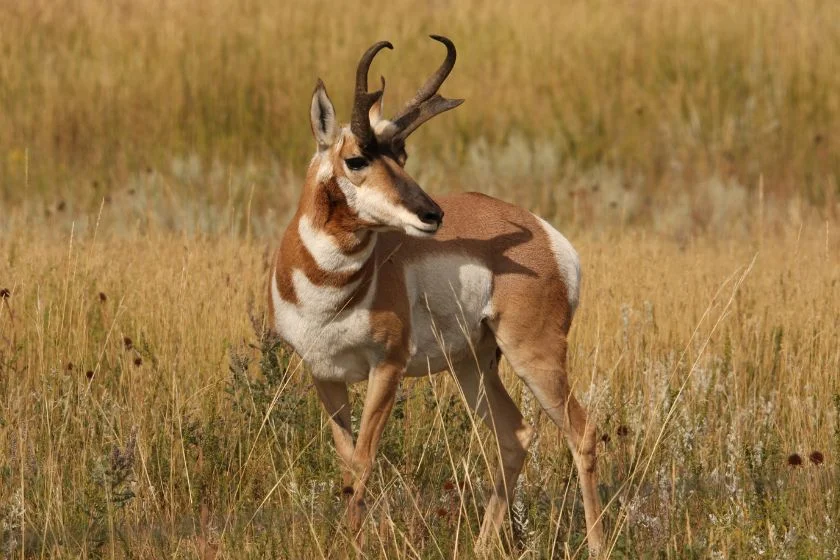
- Scientific name: Antilocapra Americana
- Classification: Mammal
- Habitat: Dry plains, deserts
- Diet: Herbivore
- Conservation status: Least concern
The pronghorn antelope is the second fastest mammal on land, reaching a speed of 60 miles per hour. They weigh up to 130lbs and are 58 inches in length.
Born with speed, the pronghorn young (fawn) at 2 days old can outrun a grown human.
Although they are herbivores, the pronghorn has been known to cause more car wreckages by running through the roads of Lake Tahoe, which sometimes result in the loss of lives.
5. Deer Mouse
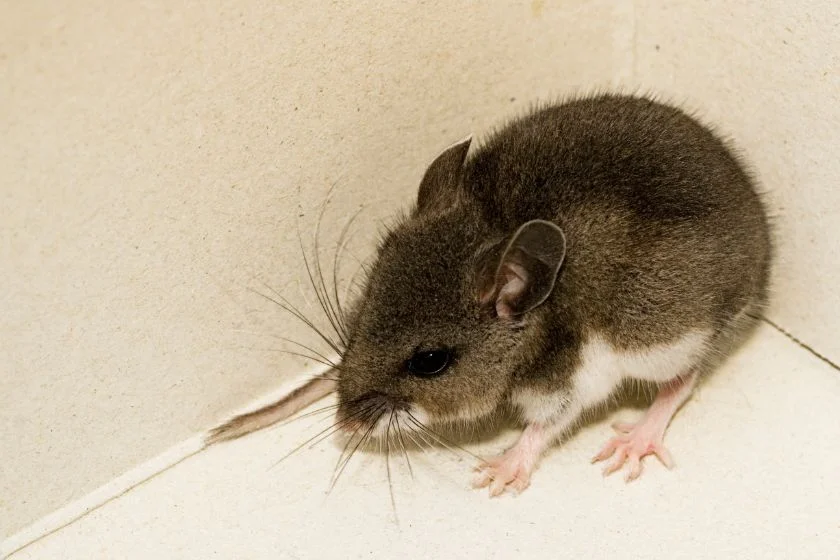
- Scientific name: Peromyscus maniculatus
- Classification: Mammal
- Habitat: Woodland, brushland, grassland, forest, desert.
- Diet: Omnivore
- Conservation status: Least concern
The deer mouse is also known as the eastern deer mouse. These creatures are known as the deer mice because their fur looks like a deer’s skin, dark on its surface and white on its hinds, stomach, and tip of its tail.
They can grow, reaching a length of 10cm, and weigh up to 20g. The deer mouse is nocturnal, spending most of the day in trees or holes where they mostly make their habitat.
These animals are carriers of a deadly virus called the Hantavirus. They spread the virus through their poop and urine, which can be fatal when exposed to humans.
According to the Centers for Disease Control, the total number of cases in Nevada is 28. The Hantavirus is gotten by having contact with the rodent or its nest.
6. Mule Deer

- Scientific name: Odocoileus hemionus
- Classification: Mammal
- Habitat: Sub-tropic, extreme desert.
- Diet: Herbivore
- Conservation status: Least concern
The mule deer, known to be meek and very peaceful, is one of the biggest threats to the natives and visitors of Lake Tahoe.
They have been known cause more automobile wreckage than any other animal in the countryside. One is likely to hit a full-sized buck in the rut than get a shark bite.
That is why most states are taking on sterilization programs to control the number of deer on the road.
7. Leeches
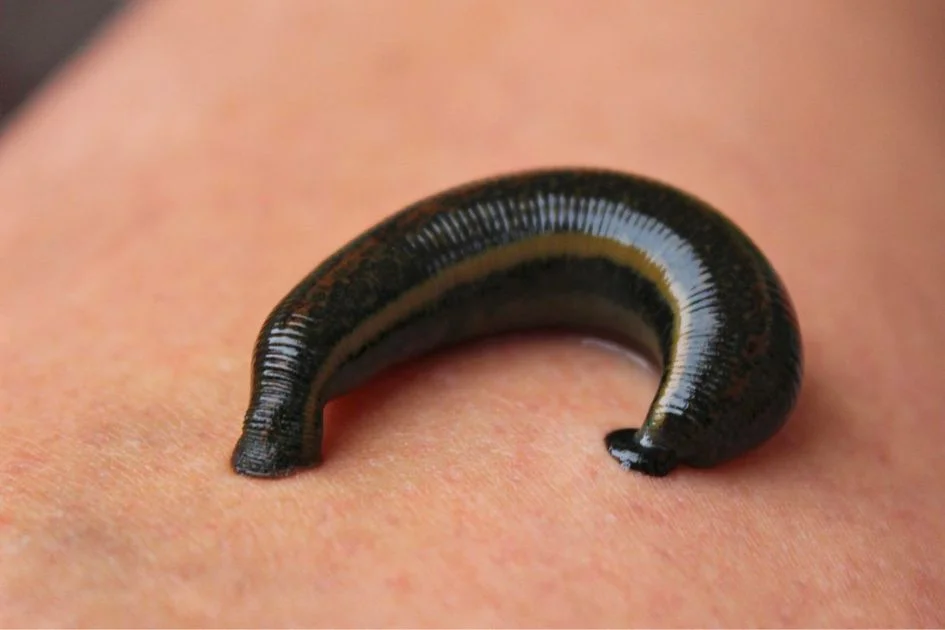
- Scientific name: Hirudinea
- Classification: Clitellata
- Habitat: Freshwater pond, lake
- Diet: Carnivore
- Conservation status: Least concern
These leeches are well-known bloodsuckers hence the name leech (always taking).
Leeches are dark, fat earthworm-like species that vary in size and color depending on geographical location.
They use their tiny rows of teeth to stay on the skin of their prey and suck its blood.
Although these leeches are not dangerous to humans, they can inject bacteria into their prey. They have three rows of small teeth, and these teeth are the reasons why you can’t feel it bite.
However, the good news is that it takes about 300 – 400 leeches to suck out blood from the human body.
8. Black Bear

- Scientific name: Ursus Americanus
- Classification: Mammal
- Habitat: Forest, woodland
- Diet: Omnivore
- Conservation status: Least concern
The black bear sometimes called the American black bear, is generally not an aggressive animal as it tends to co-exist peacefully among humans.
Although these bears are carnivorous, they rely mainly on available fruits and honey.
However, these peaceful bears are known to become aggressive and attack when threatened in their habitat.
9. Garter Snake

- Scientific name: Theosophies sirtalis
- Classification: Reptile
- Habitat: Forests, fields, wetlands, and marshes
- Diet: Carnivore
- Conservation status: Endangered
The garter snakes are generally not dangerous to humans as they are non-venomous snakes.
However, their saliva contains little amount of venom that can be toxic to their prey making its bite harmless to even smaller prey.
While studying mice in the lab to know which is more lethal the garter’s saliva or bite, research has shown that the saliva secretion is high venomous and when introduced into the bloodstream of the mice it was lethal.
When the common garter attacks humans by using its toxic saliva, below are some of the symptoms to be experienced;
- Vomiting
- Slight swelling in the affected area
- Dizziness
- Skin irritation
But to avoid all these, wash the affected area thoroughly with soap and warm water.
10. Great Basin Rattlesnake
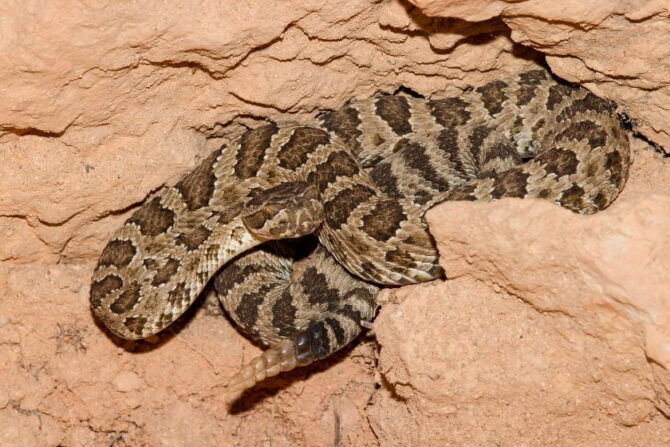
- Scientific name: Crotalus atrox
- Classification: Reptile
- Habitat: Under vegetation, rocks, waterside
- Diet: Carnivore
- Conservation status: Least concern
The Western Diamondback, also known as the basin rattlesnake, is one of the most notorious snakes in the United States. These well-known Lake Tahoe snakes are members of the Pit Viper family.
This venomous killer has a special detector on both sides of its head that detects heat, giving them a thermal image of everything around them.
Also, you can sense their presence by listening to the rattling sound the snake gives when it’s getting closer to you.
These snakes are not hostile and won’t chase you unnecessarily; however, they hold their ground when cornered. They don’t always give rattling sounds; they sometimes stay silent and hidden.
They are a little more agitated than any other type of snake and will bite at any given opportunity. Although, they will be happy to get out of your way if you keep your distance.
Lake Tahoe Wildlife Safety Tips
- When you find a wounded animals such as mice, chipmunks, and other smaller animals, always use gloves when touching or getting in contact with them. However, when you encounter a larger animal like a bobcat, bear, and so on, always call the appropriate official or ranger as they will always know how to approach the animal.
- Bears have been known to raid homes and campsites due to their keen sense of smell. Always wash all cookware thoroughly and keep all uneaten food or snacks in a tight container.
- While sightseeing and hiking, always keep a safe distance between yourself and the animals in order not to provoke an attack by encroaching on their territory.
- Never feed the animals. This is something that is always emphasized to campers and hikers. When you feed the animals, they tend to return for more until there is nothing left and attack.
Conclusion
Exploring the wildlife in Lake Tahoe can be a very exciting experience.
Nevertheless, it is important to always treat these animals with the utmost respect for peaceful co-existence because they play an important role in ecological balance.
So, keep your distance from these most dangerous animals in Lake Tahoe as much as possible to avoid being attacked.
